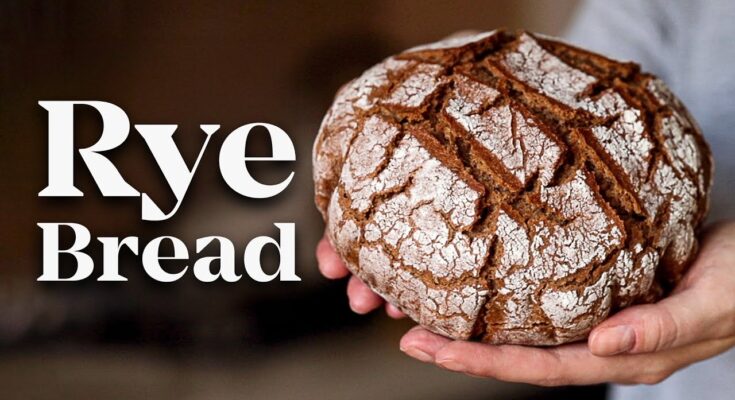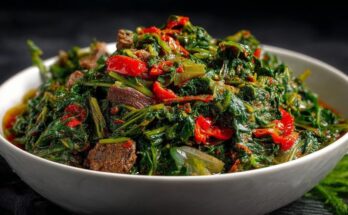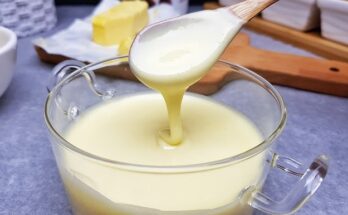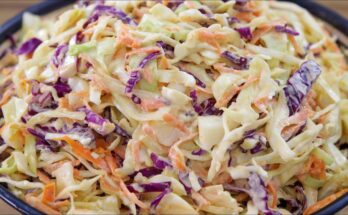Rye Bread Recipe: Rye bread is a type of bread made primarily from rye flour. It’s denser, darker, and richer in flavor compared to traditional wheat bread. With its hearty texture and earthy taste, rye bread is a staple in many European countries like Germany, Poland, and Sweden. Whether used for sandwiches or enjoyed plain, it’s an incredibly versatile bread.
Why Choose Rye Bread?
If you’re tired of the same old white bread and want something healthier and more flavorful, rye bread is a fantastic choice. Not only is it packed with nutrients, but it also boasts a tangy, robust flavor that sets it apart. Plus, rye bread pairs well with savory and sweet toppings, making it a great option for various meals.
Benefits of Rye Bread
Nutritional Value of Rye Bread
Rye bread is a nutritional powerhouse. It contains a significant amount of fiber, which aids digestion, and is rich in vitamins like B1, B2, and E. Additionally, rye flour is packed with minerals like magnesium, iron, and zinc. Compared to regular wheat bread, rye bread has a lower glycemic index, making it an excellent choice for managing blood sugar levels.
Health Benefits of Including Rye in Your Diet
Rye bread isn’t just delicious—it’s good for you too! The high fiber content promotes better digestion and helps you feel fuller longer, which can aid in weight management. The nutrients in rye flour also support heart health, boost immunity, and improve overall energy levels.
Ingredients for Rye Bread
Essential Ingredients
To make rye bread, you’ll need:
- Rye flour: The star of the recipe, it gives the bread its distinct flavor.
- All-purpose flour: Helps balance the density of rye flour.
- Water: Warm water helps activate the yeast.
- Yeast: Active dry yeast is commonly used for this recipe.
- Salt: Enhances the flavor of the bread.
- Sweetener: Molasses, honey, or sugar adds a touch of sweetness.
Optional Additions for Extra Flavor
For an enhanced flavor profile, you can include ingredients like:
- Caraway seeds: A traditional addition for a distinct taste.
- Sunflower seeds: Adds crunch and texture.
- Dried fruits or nuts: For a sweet and savory twist.
Tools You’ll Need
Must-Have Baking Equipment
- Mixing bowl
- Measuring cups and spoons
- A sturdy wooden spoon or stand mixer with a dough hook
- A kitchen scale (optional but helpful for precise measurements)
- A bread pan or baking sheet
- A clean kitchen towel
Useful Tips for Setting Up Your Baking Space
Before you start baking, ensure your kitchen is clean and organized. Pre-measure all your ingredients to save time and avoid errors. It’s also a good idea to preheat your oven and line your baking pan with parchment paper for easy cleanup.
Step-by-Step Instructions to Make Rye Bread
Step 1: Preparing the Ingredients
Start by gathering and measuring all the ingredients. Warm the water to about 110°F (43°C)—it should feel warm but not hot to the touch. If using caraway seeds, toast them lightly to bring out their flavor.
Step 2: Mixing the Dough
In a large mixing bowl, combine the rye flour, all-purpose flour, salt, and sweetener. In a separate bowl, dissolve the yeast in warm water and let it sit for 5–10 minutes until it becomes frothy. Gradually mix the yeast mixture into the dry ingredients, stirring until a shaggy dough forms.
Step 3: Kneading the Dough
Turn the dough onto a floured surface and knead for about 8–10 minutes until it becomes smooth and elastic. If using a stand mixer, knead with the dough hook on medium speed for 5–6 minutes.
Step 4: Proofing the Dough
Place the dough in a lightly oiled bowl, cover it with a clean kitchen towel, and let it rise in a warm spot for 1–2 hours or until it doubles in size.
Step 5: Shaping and Final Rise
Punch down the dough to release any air bubbles and shape it into a loaf. Place the loaf on a baking sheet or into a bread pan and cover it again. Let it rise for another 30–45 minutes.
Step 6: Baking Your Rye Bread
Preheat your oven to 375°F (190°C). Bake the bread for 30–40 minutes or until it sounds hollow when tapped on the bottom.
Step 7: Cooling and Storing
Allow the bread to cool completely on a wire rack before slicing. Store it in an airtight container or wrap it in a clean kitchen towel to maintain freshness.
Tips for Perfect Rye Bread Every Time
Common Mistakes to Avoid
- Don’t skip kneading! Proper kneading develops gluten, giving the bread structure.
- Avoid adding too much flour while kneading, as it can make the bread dense.
- Be patient during the proofing stages—good things take time!
Adjusting the Recipe for Different Flavors
Want to get creative? Add herbs, spices, or even grated cheese to the dough. You can also experiment with different sweeteners, like maple syrup or agave.
Variations of Rye Bread
Light Rye Bread
Light rye bread uses a combination of rye flour and a higher proportion of all-purpose flour, creating a milder flavor and lighter texture. It’s perfect for those new to rye bread or looking for a softer loaf. Light rye pairs wonderfully with deli meats and cheeses, making it a go-to for sandwiches.
Dark Rye Bread
Dark rye bread is made with whole-grain rye flour, often enhanced with ingredients like molasses or cocoa powder to deepen its color and flavor. It has a bold, earthy taste and a denser texture, making it ideal for pairing with hearty soups, stews, or smoked fish.
Sourdough Rye Bread
Sourdough rye bread combines the tanginess of a sourdough starter with the nutty flavor of rye. The natural fermentation process adds depth and a slight chewiness to the bread. This variation is a favorite among artisan bread lovers and works great as a base for avocado toast or rustic sandwiches.
Serving Suggestions
Best Pairings for Rye Bread
Rye bread’s robust flavor pairs beautifully with a variety of foods. Here are some popular options:
- Savory toppings: Smoked salmon, cream cheese, or pastrami.
- Sweet spreads: Butter and honey, jam, or Nutella.
- Soups and stews: Use rye bread to soak up the rich flavors of borscht or split pea soup.
Rye Bread in Traditional Dishes
Rye bread is a staple in many traditional dishes around the world:
- Reuben sandwich: A classic American favorite with corned beef, Swiss cheese, sauerkraut, and Thousand Island dressing.
- Smørrebrød: Danish open-faced sandwiches with various toppings like pickled herring, boiled eggs, and dill.
- Pumpernickel bread: A German variation often served with butter and cured meats.
FAQs about Rye Bread Recipe
What is rye bread made of?
Rye bread primarily consists of rye flour, which gives it a distinctive flavor compared to wheat bread. It often includes a mix of flours and can be made with various additional ingredients such as seeds and spices to enhance its taste and texture.
Is rye bread healthier than wheat bread?
Rye bread is generally considered healthier than white wheat bread. It’s high in fiber, which helps in digestion and provides a feeling of fullness. Rye also has a low glycemic index, which means it doesn’t cause a rapid spike in blood sugar levels.
Can I make rye bread without a bread machine?
Absolutely! While a bread machine can simplify the process, you can also make rye bread by hand. Mixing, kneading, and baking the dough in a conventional oven can yield delicious results and give you more control over the shape and crust of your bread.
Does rye bread need a special yeast?
No special yeast is required. You can use standard baker’s yeast for making rye bread. Some recipes might suggest using a sourdough starter, which isn’t a yeast but a culture of lactic acid bacteria and wild yeasts, to add depth to the flavor.
How long does homemade rye bread last?
Homemade rye bread typically stays fresh for about 3 to 4 days when stored at room temperature in a bread box or a similar airtight container. You can extend its shelf life by refrigerating or freezing it.
Can I add other grains to my rye bread recipe?
Yes, you can mix rye flour with other grain flours such as wheat, barley, or oat to tweak the flavor and texture of your bread. Adding different grains can also enhance the nutritional profile of your bread.
Is rye bread suitable for a gluten-free diet?
No, rye bread is not suitable for a gluten-free diet as rye flour contains gluten. If you are looking for gluten-free options, consider breads made from almond, rice, or coconut flour.
Conclusion
Rye bread is more than just a bread option—it’s a culinary delight with deep roots in tradition and health benefits. With its rich flavor, dense texture, and nutritional profile, it’s a fantastic addition to any kitchen. Whether you’re making a simple sandwich or serving up a traditional dish, rye bread stands out as a flavorful and versatile choice. By following this step-by-step guide, you can bake your own loaf of rye bread at home, tailored to your taste and style.
So why not roll up your sleeves and start baking today? You’ll enjoy the process and, even more, the taste of freshly baked rye bread that’s made with love.



